Dick Lewis, of Chester, New Hampshire, has been logging since he was a teenager in the late 1950s. He started with horses and then a farm tractor, each of them pulling a scoot, a rugged sled that kept the logs off the ground. With the leverage of a peavey and a strong back, he loaded the scoot. If a horse was doing the pulling, he’d load 300 to 500 board feet of logs; with the tractor, he’d load 800 feet. Later, using a Caterpillar D4 bulldozer, he could pull 2,000 board feet. At the landing, he unloaded the scoot onto a raised skidway. When the skidway was full, he parked the truck below it, and rolled logs onto the truckbed. He still wasn’t done. After he drove to the mill, he unloaded the truck by hand.
Having handled each log at least five times, he’d gotten to know them all quite well. “I knew my chiropractor really well, too,” he said.
Most loggers who worked in the 1940s and 50s will describe a similar setup. Loggers were happily discarding their crosscut saws – perhaps mounting them on the barn wall as relics – and hefting the new chainsaws, which by 1948 were portable enough to be handled by one man. That was a sea change for most loggers, but the most significant technological shift in Lewis’s logging career was the introduction of the truck-mounted log loader. Before long, scoots and log-length wood were gone, and cable skidders were pulling hitches of tree-length wood. They didn’t pull whole trees – that would come later with grapple skidders – but trees that had been delimbed. Lewis bought his first cable skidder in 1972, and for many years he was a one-man operation – a man, a saw, and his skidder.
Engineering innovations have continued to change the way logging is done and, as with the log loader, most advances have increased production and enhanced safety. More recently, as concerns over environmental impact have heightened, engineers have developed equipment that reduces damage to soil and remaining trees.
The logging operations going on in your area most likely fit into one of three categories: hand felling and a cable skidder (tractors and horses still play a role); feller-buncher with grapple skidder, delimber, and slasher; or a cut-to-length harvester with a forwarder. Here’s a closer look at what’s going on in each type of operation.
Hand felling
Hand felling and cable skidding continues to be the least expensive way to enter the trade. Well-maintained skidders and tractors have long lives, and used equipment is readily available. Aspiring loggers can find a no-frills 1970s John Deere or Timberjack skidder starting at $15,000, and a new professional-grade chainsaw for around $500.
Across the Northeast, a few thousand loggers are making a living with a chainsaw and a cable skidder. Those who learn to market their logs effectively can make a viable living. Loggers who stay in the business are likely to add a dozer, maybe an excavator, so they can build their own roads instead of having to contract that job out. In some cases, this accumulation of big iron starts a logger down the road to mechanization and a larger payroll.
As Dick Lewis noted, using a skidder is less grueling than loading and unloading a scoot by hand, but it is still dangerous and demanding work. The logger has to cut the tree and delimb it – picture a gnarly spruce with a whorl of branches every 6 or 12 inches. He then backs the skidder up what is often a gut-wrenching incline, drags a steel cable to the tree, and wraps one of its chokers around the tree’s butt for skidding. Not many of us could stand up to the beating these guys take, scrambling into the skidder’s cab, jumping off, felling 30 or 40 trees a day with a chainsaw.
Jack Frost, a long-time logger in Maine who now sells logging equipment, started in high school with a chainsaw and a tractor, but before long his physical condition led him to idle his saw. “It’s a young man’s game,” he said. “You can do it for 10 or 20 good years, but it starts taking its toll on your body.”
Hand cutters do best when they have large-diameter trees to cut. Because of the attention they can give to each tree, they are in a good position to make the best decisions on how to buck a tree into the logs that will bring the most money from the mill. Particularly with hardwood and white pine sawlogs, good bucking decisions can dramatically increase revenue.
Cable-skidder loggers thrive on smaller woodlots because their operating costs are lower than mechanized outfits. Every time he starts at a new jobsite, a logger has to have his equipment trucked there. A single cable skidder might cost $200 to move, while moving the armada of equipment required in a whole-tree harvest might cost five or six times that. A low skidder loan payment and low operating costs means a logger doesn’t need to produce huge volumes of wood, though an industrious logger working in softwoods can fill a small logging truck with about 4,000 board feet in a day.
Mechanical harvesting
In 1975, an outbreak of spruce budworm began killing millions of spruce and balsam firs across the northern forest. Many landowners tried to salvage as much of their softwood as possible.
The outbreak lasted approximately 10 years, and hand cutters and cable skidders couldn’t keep up with the demand, so feller-bunchers and grapple skidders jumped into the fray. Then, in the early 1980s, wood-fired power plants sprang up across the Northeast, bringing a hunger for wood chips. To supply that market, even more loggers bought bunchers and grapples, and they’ve been here ever since. A new feller-buncher can cost $500,000. Add two grapple skidders at nearly $400,000 each, a delimber and a log loader, and before long your loan payment could be large enough to buy a small house every month. With that cost hanging over your head, you’d better be processing lots of wood.
The daily output of a feller-buncher can be more easily measured in acres than in board feet. Bryce Limlaw, who operates a feller-buncher for his father’s company, Limlaw Chipping and Land Clearing in West Topsham, Vermont, estimates that he can thin two acres a day, and if the job is a land clearing job, he can cut four acres a day. On harvests with a large volume of lowgrade wood going to pulp or chip markets, mechanical harvesting is the best choice.
Let’s look at the feller-buncher, the heart of the system known as conventional mechanized harvesting. Ignore its cutting head for a moment, and what you’ll see is an excavator: it rides on tracks, and the logger sits in an enclosed cab operating a boom that can reach out 25 feet or swing in a tight 360-degree rotation with the cab. Swap out the excavator’s bucket for a 5,000 pound cutting head and you’ve got a feller-buncher. The cutting head has two arms that grip the tree and another that holds previously cut trees in place on a platform. The saw, known as a hot saw, uses the centrifugal force of its 500-pound rotating blade to plow through a tree up to 24 inches in diameter. Some feller-buncher heads use a chainsaw-style bar saw, and earlier versions used a shear, a powerful pair of scissors. But when the job requires cutting thousands of small trees, loggers use a hot saw.
A feller-buncher is like a 40-ton weedwhacker, but instead of spraying weeds all over the place, it collects each one as it goes. When the operator has accumulated a bunch – thus the name, feller-buncher – he positions the trees on the skid trail so the grapple skidder can grab the bunch with its opposing pincers and drag it to the landing. A grapple can skid more wood than any cable skidder, and it picks the load up in one movement. No climbing in and out, no chokers to set and then release. A grapple operator spends all day in the cab, focused on moving trees from the woods to the landing, but the feller-buncher is so efficient that it typically takes two grapple-skidders to keep up.
On the landing, the trees are delimbed and cut into logs by a slasher – a large circular saw mounted on a bunk. The logger uses a loader with a boom and grapple to pick up a tree and position it on the slasher, which then zips it to a specific length depending on the product. Sawlogs go in piles according to species; pulp goes in another pile. If the tops, branches, and limbs are going to be chipped, they will be piled for the chipper. If not, the grapple skidder will pick up a pile of the debris and carry it with him on his return trip to the woods. He’ll drop the brush into low spots or wet areas on the skid trails to stabilize them and keep them from washing out. As he does this, he maintains radio contact with the feller-buncher operator to coordinate their actions.
No matter which piece of equipment the logger is running, he is working from the safety of an enclosed cab, which shields him from the controlled chaos of high-speed wood processing. In some states, that reduces the company’s rate for workers’ comp insurance, with the difference most dramatic in New Hampshire, where manual fellers pay $44.67 per $100 of payroll, as opposed to $9.40 for mechanical.
Cut-to-length
If a mechanized operation with feller-bunchers and grapple skidders is a heavyweight boxer, a cut-to-length system is a welterweight. It’s not lacking in power, but it has a lot more finesse.
A CTL harvester can ride on an excavator-style carrier or one designed specifically for logging in tight spaces. Some carriers have tracks, others use broad rubber tires. The cutter can be a fixed or dangle head. Across the region, tracked systems are twice as common as those on rubber tires, but there’s only a slight preference for dangle heads over fixed heads. Rod Lampe, of Putney, Vermont, prefers the dangle head because it allows him to use a small carrier. “With a fixed head, you need a bigger carrier, because you are holding the tree and carrying it. With the dangle head, you just control the fall, then pick it up and slide it through the delimbing knives,” he said. The smaller carrier means he can maneuver in tight spots to pluck out single trees in a thinning job.
Lampe had been logging for 10 years when he had a moment of truth similar to Jack Frost’s. The vibration from running a chainsaw all day had given him carpal tunnel syndrome. “I saw myself getting older and didn’t want to be doing that work for the rest of my life. I just knew I had to do something different, so I took a chance and bought a CTL harvester,” he said.
With no training available to him, he floundered. After running it for two weeks, he was sure he’d made a big mistake.
Frost was also challenged by the complexity of the equipment and the lack of available training. “It was a disaster for me,” he said. “In Scandinavia, where these machines came from, loggers go to school for two years, studying business, mechanics, hydraulics, and forestry. Then they finally get to operate a machine. We made fun of them, but when many of us failed at it, we stopped laughing.”
Frost and Lampe are not the only loggers to have had difficulty adjusting to a CTL system. A cost-benefit analysis prepared for Sustainable Forest Futures and Lyme Timber Company showed that most CTL loggers had no choice but to learn the new technology on the job, without much support from the manufacturers.
Still, Lampe stuck with it, replaced his first machine with his current Fabtek, and now – nine years into it – he is totally committed to CTL. He works in partnership with Long View Forest Contracting of Westminster, Vermont, and serves as a mentor to Long View’s new CTL operators.
Why is it so challenging? A harvester is more complicated than a feller-buncher because it does more tasks. A logger running a harvester grasps the tree and cuts it, controlling its direction of fall by putting pressure on it. He then holds the tree in a horizontal position and engages spiked rollers to propel the whole tree through a set of onboard delimbing knives. With the log cleaned up, he returns to the butt end and runs it through the rollers again. A sensor measures the tree’s length, and the bar saw (the same saw that felled the tree) cuts logs to a predetermined length.
This single machine is doing work previously done by three machines: feller-buncher, delimber, and slasher. And it’s doing all of it in the woods, which is one of the main reasons that many foresters and landowners prefer this technology – the tops and limbs stay in place, cushioning the forest floor, and the landing can be considerably smaller because it doesn’t need to accommodate so much equipment.
The logs are carried to the landing on the bunk of a forwarder, which could be viewed as the perfection of the truckmounted log loader. It has a boom and grapple to load logs into its bunk, and its balloon-like tires minimize its pressure on the ground. Because it carries logs instead of skidding trees, it doesn’t dig up the soil. Dragging its load across soggy ground, a grapple skidder or cable skidder can create ruts that will never disappear, so they have to stay out of the woods in mud season. Even with its heavier load, a forwarder can operate successfully on softer ground, which means that CTL loggers can work more weeks of the year.
The first-generation CTL equipment worked well in Sweden’s and Finland’s flat ground and monoculture softwoods, but the technology required re-engineering to work in the more varied terrain and forest types of the Northeast. Today, you’ll find CTL crews that can work in any of the terrain that conventional mechanical can, though CTL doesn’t pile up the wood as quickly.
Which one?
If you want to start a ruckus, go to a meeting of loggers and foresters and ask, “Which is the best system?” Proponents of any of the three can make an impassioned case for why their system is the most profitable, why it provides the best return to landowners, why it does the least amount of damage to the woods, and why it is the future of the industry. Of course, none of the three systems is right for every situation.
If a landowner wants to see all the branches, limbs, and tops stay in the woods for nutrients and shelter for animals and seedlings, handcutting or CTL accomplishes that. A person who wants to have the woods cleaned of all that mess will choose conventional mechanical.
Mechanical harvesting is clearly the best way when a harvest entails removing large volumes of low-grade wood. Small woodlots generally favor handcutting, but CTL can pile logs on postage-stamp landings and profit from jobs with a preponderance of small-diameter, low-value trees – jobs that a hand-cutter would avoid.
Hand cutters have a distinct advantage in a forest with highvalue hardwoods, where they can maximize value by paying close attention to detail.
Lampe said, “You can’t see the log’s grade from the cab, so I don’t try to buck good hardwood from the cab.” When he fells a promising tree, he’ll climb down, carrying paint and a tape measure, and mark where to make the cuts. “If the job has a lot of higher-grade hardwood, we hand fall the larger trees.”
Long View’s combination of hand-felling and CTL demonstrates how difficult it is to draw clear lines of distinction between the systems. Loggers tinker with their equipment mix and often end up with hybrids. Some hand-fellers use a forwarder. Some contractors own both a feller-buncher and a CTL harvester.
A good logging job is one that provides fair and adequate return to the landowner and the logger. It leaves behind a forest with little or no damage to its soils, watercourses, and residual trees. Each of these three harvesting systems – and hybrids of them – can do a good job if the logger is committed to both production and protection of the woods.
Scoots, skidders, and hotsaws
Here’s a quick sketch of the evolution of logging equipment beginning in the 1940s.
Chainsaws replace crosscut saws and axes after World War II when they became light enough to be operated efficiently by one man. 1948
Crawler tractors and farm tractors pull logs out of the woods on scoots, emulating the horses and oxen they replace. 1940s through 60s
Truck-mounted log loaders drastically reduce the amount of loading and unloading that has to be done by hand. 1960s
Winches are added to tractors to replace scoots. The winches are equipped with a long cable and choker chains to pull more than one log at a time in a hitch. Ground skidding means that logs arrive at the mill caked in mud, so sawmills install debarking equipment. 1950s
Cable skidders with articulated steering are developed. It separates the machine into a front and back half connected through a central pivot point, which allows tighter maneuvering and enables the machine to operate on rougher terrain. Because the front axles are stationary like rear axles, they are more rugged than the front axles of a tractor. Late 1950s
Skidding becomes more mechanized with the development of grapple skidders. 1970s
Mechanical harvesters like the feller-buncher are introduced; they increase both safety and production. 1970s
Cut-to length (CTL) cutter heads do the work of three machines: they cut the tree, bring it to horizontal, delimb it, measure logs out of it, and cut them to length. Late 1980s
Forwarders carry logs, rather than skid them, reducing the environmental impact on the forest floor. Late 1980s


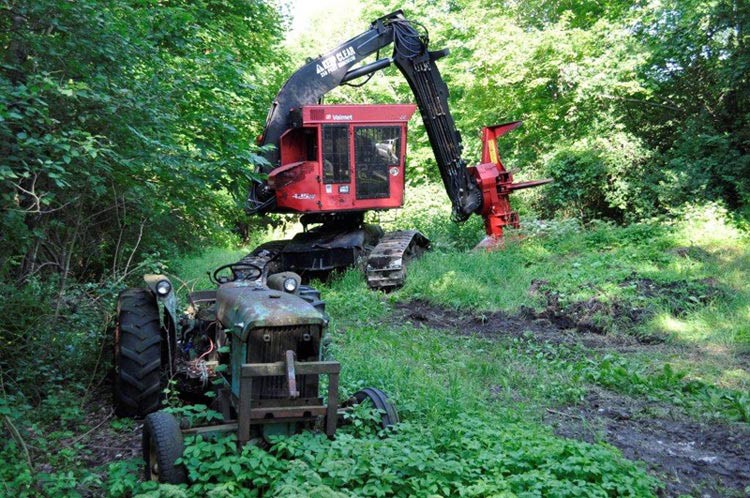
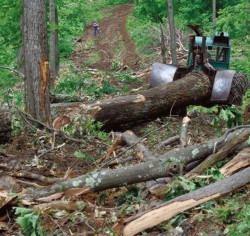
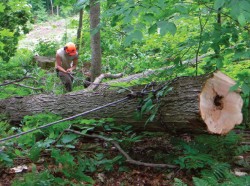
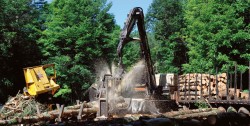
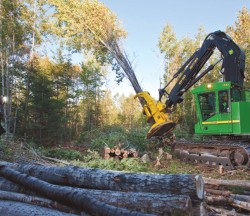
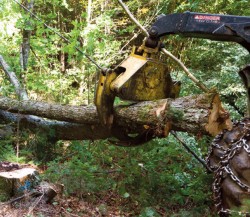
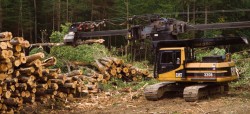
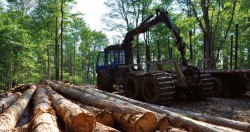
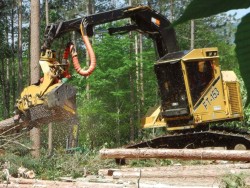
Discussion *